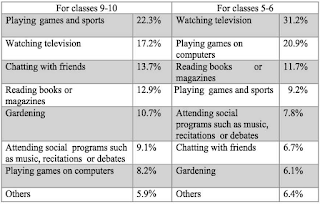A. Tiya and Anusha decided to make a survey on students' pastimes in their class. After the survey they presented their findings in a chart. Look at the chart and read how they explain their findings.
Tiya: Hello everyone! My name is Tiya. My friend, Anusha and I are going to do a presentation on Pastime Habits of Classes 9 and 10 students in our school. There are 120 students, 60 in class 9 and 60 in class 10. The classes have gender equity. Each class has 30 male and 30 female students. The survey shows that 22.3 percent of students in classes 9-10 like games and sports as their most favourite pastime, which is the 4lh option given by classes 5-6 students. Watching television is the second choice (17.2%) by the first group in contrast to 31.2% of the second group. It is noteworthy that watching television is the first choice of the second group. A considerable number (13.7%) of 9-10 students like to chat with their friends and thus it becomes the third popular choice in the chart while this becomes one of the less important choices by the younger kids. Only 6.7% of the kids take it as their first priority. It's interesting that both the groups like reading books. 12.9% of students of classes 9-10 take it as their favourite pastime. The number is 11.7% for Classes 5-6 students. Besides, gardening is voted (10.7% of students) to be the 5th preference by the grown up group though it is not that much liked by the younger group. Only 6.1 % of the young kids are involved in it. This is interesting that though the higher number of students in classes 9-10 prefer attending social programs (9.1%) than students of classes 5-6 (7.8%), yet as a choice it is preferred by the latter group. It is the 5 th choice for them while to the older group it is the 6th. Young kids have greater fascination for playing games on the computers (20.9% like it as their first choice). The chart shows that as the kids grow up, they lose their passion for computer games. According to the chart the ratio declines to 8.2% from 20.9% when the kids are students of classes 9-10. Finally, it can be said that the influence of television has impact on both the groups but the more students grow up, the more they opt for fields/ gym.
Questions
1. What are the gender policy of the surveyors?
2. What are the survey findings regarding watching television?
3. Which age group is more interested in socializing with others?
4. According to the chart, how do the kids change their pastimes when they are grown up? What changes does the chart for 9-10 reflect ?
B. Work in groups. Make a chart on the pastimes of the students in your class and present it to your class.
If you want to read the next lesson of this unit please click the link below:
If you want to read the next lesson of this unit please click the link below:






0 Comments:
Post a Comment